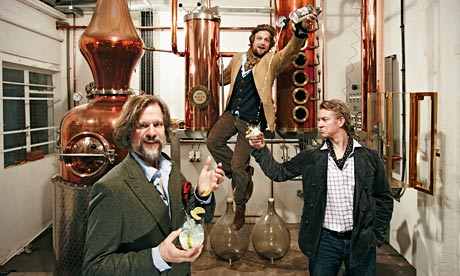
There's something of the mad scientist's laboratory about Sipsmith's HQ. It's a garage, basically, on a suburban west London street, and looks like a cross between Dr Frankenstein's workshop and a crystal meth lab. Or how a crystal meth lab might have looked had they existed in Victorian times, because dominating the single room is a beautiful, hissing, copper still.
And then there are the proprietors, whose names suggest that they too have stepped out of the 19th century; Stamford Galsworthy and Fairfax Hall, and soft-spoken master distiller Jared Brown, from New Orleans, who has created spirits all over the world.
The only evidence that we're in the 21st century is the presence of Chris Garden, a graduate of Edinburgh's Heriot-Watt University, "the Harvard of brewing and distillation" as Stamford, or Sam as he likes to be known, calls it. Chris is hunched over a laptop and seems to be keeping an eye on what's going on. "We took him on last year and he came straight in and just started correcting our mistakes," says Galsworthy.
It's a brilliantly homemade set-up, although Fairfax Hall ("We call him 'stately' sometimes as in short for 'stately home'," says Galsworthy) is out meeting the bank manager when I arrive. Because even though they only launched their first gin and vodka a year ago, they are already stocked by the Dorchester, the Savoy, and the Langham, they're in Harvey Nicks, Majestic and Oddbins. There's talk of moving to bigger premises. And creating a sister for "Prudence" – the still. "All stills have female names," says Galsworthy. "And she's named after my late mother. And, you know, to have a bit of a dig at Gordon Brown."
Prudence was made by a family firm in Bavaria and produces about 280 bottles a day using old-fashioned technology. "We're not trying to re-invent the wheel," says Galsworthy. "What we are trying do is reflect the way that gin used to be made. What we want to do is to celebrate the old-school way of doing things in the modern era."
The old-school way of doing things, as told to me by Brown, is a remarkable story, beginning in 1689 when William of Orange passed an act that banned the import of spirit as a means of dealing with a surplus of grain, and ending in 1830 with the Sale of Beer Act, that dropped the tax on beer and made Britain again a nation of beer drinkers. In between, were the gin years, as depicted by Hogarth in his engravings of Gin Lane (although Brown insists this was propaganda sponsored by a beer company), a time when 9,000 children a year died of alcohol poisoning. And "one in four habitable structures in London had a working gin still".
Really?
"Really. And some of them were producing phenomenal gin. And others were shovelling sawdust off the tavern floor."
There was a brief hiatus of 191 years. And then along came Sipsmith, the first gin to be made in London for nearly two centuries. "It took Revenue and Customs 18 months to issue us with a licence, basically because they didn't know how to."
Sipsmith has spearheaded a revival in London gin – although it's hard to think that anyone else will go to quite such lengths for authenticity. "We really wanted to use a source of water that old London distilleries would have used, so we Google Earthed the path of the Thames and zeroed in on this tiny copse in the Cotswolds, cold-called the farmer, and we go and collect 1,000 litres at a time out of his borehole."
It's a properly artisanal, local production. All white spirits in Britain are produced by seven large-scale distilleries, mostly on stainless steel stills. The idea for a small-scale, hand-crafted alcohol came from Galsworthy's travels around the States as export manager for the London brewery Fullers. During his eight years there, he saw micro-distilleries springing up and decided he wanted to do the same in Britain, and partnered up with his childhood friend, Hall, who had been working for the food and drink giant Diageo. When they met Brown, everything fell into place.
"We knew we wanted to create a family of spirits," says Galsworthy. And it was then a matter of experimenting with the botanicals – Macedonian juniper berries, Bulgarian coriander seed, French angelica root, Spanish liquorice root, Italian orris root, Spanish ground almond, Chinese cassia bark, Madagascan cinnamon, and Spanish orange peel and lemon peel – and designing the still. They say they are the only distillery in Europe producing a "one-shot" gin – not diluted from concentrate – and only Beefeater in the UK, like them, uses copper, which reacts with the alcohol and removes the impurities.
"If you change the tiniest thing, you change the gin," says Brown, whose ancestors arrived as brewers in the States in the early 1800s. "And that's what I live for. I love the nuance. Once the formula has been nailed down the best thing to do is to keep me away from the big still." Instead he experiments on a mini-still at home in which he's currently making raspberry gin, cherry gin and damson liqueur.
We end with a tasting. "It feels a bit decadent to be drinking neat vodka at 11.30 in the morning," I say. "Welcome to our world," says Galsworthy.
I've had some practice in drinking neat vodka, from travels in Russia, and it's deliciously smooth. "You notice how there's no burn," says Galsworthy. "Good spirits warm, bad spirits burn." And the gin is all light and fragrant with hints of lemon and orange. There's no bucket, I notice, like you get at a wine tasting.
"Oh no!" says Galsworthy. "Here we do 'the Irish spit'." And we swallow it down.
Sipsmith, The Distillery, 27 Nasmyth Street, London, W6 0HA; 020 8741 2034; sipsmith.com
RUNNER UP
Paul Wayne Gregory
Award-winning Streatham chocolatier, noted for his bespoke creations.
020 8664 8966; paulwaynegregory.com

